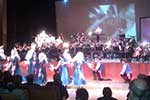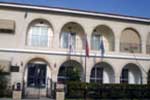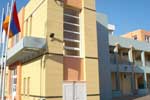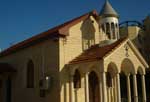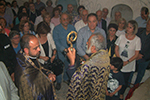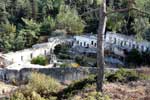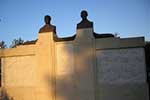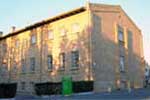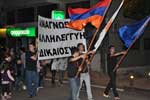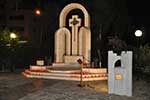Η Στήλη του Σασσουνιαν

The Court has Spoken: Can Armenians Now Unite to Build a Genocide Museum?
After an unfortunate court battle lasting nearly four years, a Federal Judge ruled last month on several suits and counter-suits filed by the Cafesjian Family Foundation (CFF) and the Armenian Assembly. The dispute revolved around plans to build an Armenian Genocide Museum & Memorial (AGM&M), two blocks from the White House.
For the first time in a court verdict, Judge Colleen Kollar-Kotelly began her 190-page ruling with the chilling words of Adolf Hitler: "Who, after all, speaks today of the annihilation of the Armenians?" She went on to explain that Hitler was referring to "the largely successful efforts by the Ottoman Turkish government to eliminate the Armenian population living on its historical homeland during the World War I era, known today as the Armenian Genocide." The Judge further added: "The Armenian Genocide is widely recognized as the first genocide of the 20th century. Of the estimated 2.1 million Armenians living in the Ottoman Empire on the eve of World War I, approximately 1.5 million were killed, and hundreds of thousands more were deported. During this period, the Armenian people were subjected to deportation, expropriation, forced conversion, abduction, torture, massacre, and starvation."
In the lawsuit, the Assembly and AGM&M claimed that Gerald Cafesjian and John Waters (Vice President of CFF) breached their fiduciary duties to AGM&M and the Assembly, that Cafesjian breached his duty of good faith and fair dealing to the Assembly, and that Cafesjian and Waters misappropriated the trade secrets of the Assembly. The Judge found all of these charges to be without merit.
In response to accusations from CFF, the Court found that “neither the Assembly nor the AGM&M breached the Grant and Transfer Agreements or their corresponding implied duties of good faith and fair dealing.” The Court also ruled that the claim for “unjust enrichment is barred by the existence of written agreements.”
Before reaching her verdict, Judge Kollar-Kotelly painstakingly reconstructed the convoluted and often antagonistic relationship between the parties, while they served together for many years on the boards of the Armenian Assembly, AGM&M and its planning committee. During their testimonies in court, several Assembly leaders could not recall basic details about meetings and events, further complicating the Judge’s task, who suspected that their "lack of memory appeared to be driven more by convenience than cognition." The Judge surmised that "the convenient lack of memory" of Assembly leaders Hirair Hovnanian, Van Krikorian, and Peter Vosbikian "is an attempt (conscious or otherwise) to minimize their involvement in an agreement that turned out badly for the Assembly." She further stated that some of the minutes of the museum committee meetings were either missing or, at least in one case, altered by an Assembly official.
The Judge traced the origins of the dispute to year 2000, when the Assembly paid $7.25 million to purchase a bank building in Washington, as a possible site for an Armenian Genocide Museum. This amount was given to the Assembly in equal sums by Anoush Mathevosian and the Cafesjian Family Foundation. CFF also provided the Assembly with a $500,000 loan. Cafesjian subsequently paid an additional $12 million to acquire four more properties next door to the bank building and donated them to the Assembly to expand the space allotted to the museum. In making this contribution, Cafesjian included in the terms of the grant agreement, signed on Nov. 1, 2003, a “reversionary clause” stipulating that the grant funds or donated properties would be returned to CFF, if the Assembly failed to develop the museum by December 31, 2010.
The museum was originally expected to open to the public on April 2002. As committee members began to argue over the scope of the project and other issues, the opening date kept getting delayed. Almost 10 years later, the museum is not expected to open anytime soon. While Hovnanian, Assembly’s Chairman of the Board, preferred a museum with a budget limited to $15 million, Cafesjian proposed a more ambitious project costing many times that amount. Cafesjian was also concerned that the controversial Turkish-Armenian Reconciliation Commission (TARC), which was strongly supported by Hovnanian and Krikorian, would discourage potential donors to the museum.
After several failed attempts to secure consensus between the "competing visions" of Cafesjian and Hovnanian, Cafesjian concluded that their differences were irreconcilable. He left the museum board and asked that the properties be returned to the CFF, as per the "reversionary agreement" signed earlier. Hovnanian angrily told Waters: "I will spend every last nickel that I have to destroy him [Cafesjian] and his foundation." On September 13, 2006, Cafesjian resigned as Chairman and President of AGM&M.
Both parties then filed separate lawsuits making a series of claims and counter-claims. The most significant outcome of the protracted litigation is Judge Kollar-Kotelly’s ruling that the reversion clause in the Grant Agreement is "valid and enforceable," which means that CFF is entitled to a return of the properties earlier donated to the Armenian Assembly. Furthermore, the court ruled that CFF retains the right to appoint one of four trustees to the AGM&M Board.
Additionally, the Judge found that, although the Assembly had breached its contractual obligation to CFF by failing to pay the March 2000 promissory note of $500,000, CFF could no longer receive this amount, as the statute of limitations had expired.
She further ruled that the AGM&M has to pay the legal expenses that Cafesjian and Waters had incurred in defending themselves against the lawsuits filed by the Assembly or AGM&M; the Court would rule later this month on the amount of legal fees to be reimbursed -- $3 million according to Cafesjian and Waters.
At the end of her comprehensive opinion, Federal Judge Kollar-Kotelly urged the two sides “to work amicably to settle their remaining disputes.” She expressed her sincere wish that “after years of fighting legal battles, the parties can put aside their differences and accomplish the laudable goal of creating an Armenian Genocide museum and memorial.”
It is clear that further legal proceedings would simply be a complete waste of time and money. If the two sides cannot come to a quick agreement on how to proceed, leaders of major Armenian-American organizations and other benefactors should step forward and indicate their willingness to come together and carry out the necessary planning and fundraising for such a vital project in the nation’s capital.
The museum’s original concept, first developed 12 years ago, could benefit from the additional input of a cross-section of the Armenian-American community. Beyond including exhibits and artifacts documenting the facts of the Armenian Genocide, the museum could be a research center for scholars and international lawyers to pursue legitimate Armenian demands from Turkey through national and international courts. The museum could also highlight not only the survival, but the renaissance of the Armenian nation, and the many positive contributions Armenians have made to America and the world community.
By Harut Sassounian Publisher,
The California Courier
«« Επιστροφή ««




